Korean E-Commerce Market Insights – 3 Reasons To Enter
Do you wish to increase the visibility of your products and introduce them in other markets? Are you searching for new recipients and advertisement strategies? Do you plan on growing your business but would rather prefer to avoid drowning in the already saturated mainstream? Well… how about South Korea? Is there a method in this madness? In this article, we’ll try to convince you of the limitless potential hidden in the Korean e-commerce market.
1. The Korean e-commerce market is ranked amongst the largest ones in the world
This might not exactly come off as a surprise, at least not until we take note of one “tiny” detail: when it comes to e-commerce, South Korea – with its 51 million residents – goes hand in hand with the United States boasting an over six times larger population!
And it truly is no mean feat, especially if we consider Korean history. This Asian country set out on the path to democracy only in the late 1980s, and it went through the phase of accelerated economic growth between 1960 and 1990. Earlier, it fought for its independence with two neighbouring empires: China and Japan.
According to the estimates provided by Statista, in 2020, as many as 92% of Koreans used the internet. By comparison – the result for Poles was 81%.
Still need more data testifying to Koreans’ love for online shopping? Be our guest:
- Over 50% of Koreans aged 60 or above actively use the internet.
- In the United States, the share of regular internet users in the same age group reaches merely 30%.
What follows, therefore, is that launching products in South Korea gives companies a golden opportunity to broaden their target audiences – exponentially. A product which populates a niche in the domestic market might just as well turn out to be a massive hit in Korea. It definitely would be worthwhile to look into the matter in greater detail.
2. There is a growing interest in foreign suppliers
From year to year, we observe a regular increase in the amount of money that Koreans leave in the bank accounts of foreign companies. Amongst the most “absorbent” industries are fashion and beauty. And even though venturing into the Korean e-commerce market requires an in-depth analysis (at Loc At Heart, we’ll gladly support you throughout the process with our communication services such as preparing Korean key words, transcreating and translating content or creating copywriting guidelines etc.), if you put in just a little bit of effort, your products or services may be greeted with open arms and gain an extra distinguishing trait – the “premium” aura that frequently surrounds brands of a foreign origin.
Example: We’ll now see how Ziaja, a Polish producer of cosmetics, fares on Gmarket, the largest and most popular e-commerce platform in South Korea. Once we enter the brand’s name, we get over 1100 hits. What is the difference in price of the same product if we compare the domestic market against the foreign one? Let’s look at the product from the very top of the list, an under-eye cream from the Kozie Mleko collection. On average, it costs PLN 6.5 in Poland, and PLN 10.4 on Gmarket.
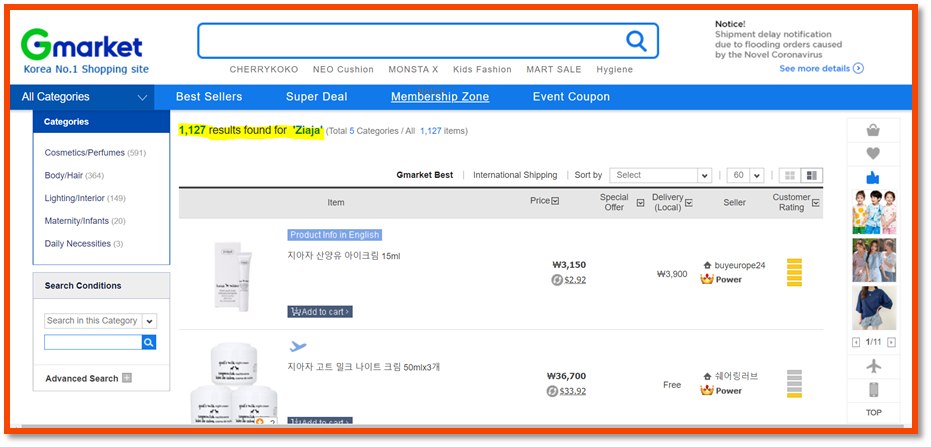
3. The Korean e-commerce market is governed by consumerist society
What offers dozens of benefits right from the get-go is the mere nature of consumers’ shopping habits. Koreans are not loyal to any specific brands, and demonstrate an openness towards change and experimenting. Companies have to regularly refresh their image to keep up with the rapidly developing market and uphold customers’ interest – hence frequent modifications to packagings and launches of new product lines.
It is estimated that in 2023 about 94% of Koreans will use e-commerce platforms. Not infrequently, online purchases – instead of meeting daily needs – are to testify to the buyer’s social or financial status.
Demanding yet profitable process
It’s certainly more difficult to enter the Korean e-commerce market than its European counterparts. The whole process calls for thorough preparations and an in-depth market analysis, including – but not limited to – consumer behaviour, guidelines related to commercial communication, most efficient marketing strategies and specific SEO requirements. The venture is, however, highly lucrative. The Korean market is fairly receptive, open to everything new. It is still far from being overfilled with foreign brands. It can generate a “wow” effect that – more often than not – is downright unachievable in the markets closest to our own.
You are now aware of the reasons why entering the e-commerce market in South Korea can be a savvy business move. Time to dig deeper into the Korean e-commerce market. Forget about Google algorithms, well-known content tactics, and the most popular payment methods you know from Allegro or Zalando. Finding your way around the Korean e-commerce market requires a different approach.
Naver leads the way. South Korea resists the charms of Google
Naver outclasses its American competitor in all available statistics. It is being used for approximately 75% of South Korean market queries. However, in no way does its design resemble Google’s minimalistic one. At first glance, Naver looks like a combination of a web portal with an online marketplace in the spirit of OLX, giving off a strong vibe of a website straight from the beginning of the 21st century.
The inconspicuous Naver is something more than just a search engine – it is a powerful network with all the tools that are important for users.
Here, before you even start typing your query, you will see the highlights: trending information, weather broadcasts or a sneak peek of the recommended purchases. You can also dive into the blogosphere and user-created content. To sum up: while Westerners say, “Google it,” Koreans say, “Naver it.”

Points to consider: The most important functionalities of Naver – e.g. the search engine, Naver Blog or Naver Café – are not available in English. The exceptions include webtoons (online comics), an English–Korean dictionary, and the sign-in page. See to it that your localised content is of the highest possible quality; otherwise you might finish the race before you even start it.
Naver is tailored to the behaviours and needs of a very specific consumer, how very different from those attributed to Western customers and visible in their purchase path. This demands a new strategy.
How does the Naver search engine work?
Long story short – in no way do its algorithms resemble the familiar Google ones.
The differences become all too apparent at the very moment we type a keyword in the search field and hit enter. At first, we will be presented with a list of paid results (a bit longer than the one we know from Google) and user-generated content from blogs or message boards. Later on, our screen will be filled with information collected from web portals, maps, books, films and other knowledge repositories. And only then, at the very bottom, can we see the usual organic results.
A concrete example – let us use the phrase “hotels in Seoul”:
Naver search results: a map of suggested accommodation points

Naver search results: blog content

Naver search results: news

Naver search results – bottom of page: organic search results

Naver Blog, Naver Café, and Q&A: the power of influencer marketing
Although the influencer marketing strategy works in European markets too, it is a particularly important pillar of e-commerce in Korea. It has a lot to do with the habits of the customers from that area. Koreans pay particular attention to the opinions of other customers and take them into account before they decide whether or not to finalise a transaction.
As many as 71% of Korean consumers are more eager to make a purchase if a product has been recommended in social media. According to yet another study, 86% of Korean women look up customer reviews on the internet before making the final decision. This information is especially valuable if your business involves children’s products and services, or if you work in such industries as beauty and fashion.
Naver search results reflect the value of influencer marketing
The design of the search engine reflects the tastes of the South Korean population. Content from blogs, Café or Q&A section is always going to be positioned higher in search results than the website of your company. Therefore, while devising a marketing strategy, you should focus on creating bonds with customers, and consult the Naver keyword planner.
Influencer marketing and South Korean weddings
The influencer marketing in South Korea is really well-developed. Almost every bride can organise a wedding virtually for free. All they need to do – within the frames of a collaboration deal with a company offering wedding packages (e.g. a wedding hall, a photo session, a wedding dress or make-up services) – is to give an account of their preparations.
They run a dedicated social media account, share photos in the message board, and give their opinions. For each of those activities one can collect points and exchange them for money or use to pay for some of the services. A youtuber (a girl from Poland) living in South Korea has taken advantage of this opportunity.
For more information about the differences between running a marketing campaign using Google and Naver, go here.
The most popular online orders categories
According to the Statista database, in 2020, the Koreans spent most on food and beverages. Next in the ranking were home electric appliances, as well as electronic and telecommunication equipment. Further down in the ranking, we can find gastronomic services, clothing, household goods, and cosmetics.
The most popular Korean e-commerce platforms
The Koreans usually make their online orders using platforms like:
- Gmarket,
- 11 Street,
- com,
- Coupang (known as “the Korean version of Amazon”).
The top 5 payment methods usually chosen by Koreans are:
- Shinhan Card – 41%
- Kakao Pay Simple Payments – 41%,
- SKT Carrier Billing – 35%
- Naver Pay Simple Payments – 34%
- Kookmin Bank Transfer – 33%

How to communicate with the Korean target group?
Bear in mind that South Korea is a country with strong Confucian traditions. Here, all business relationships and differences in age or social status are reflected in the required vocabulary and proper suffixes (“honorifics”). That is why during the preparation stage – before you embark on a marketing campaign of a product or a service – remember to use the correct style and tone in all communication related to marketing.
See both to your content (Koreans pay attention to other product qualities than Europeans) and the form of expression, which might require a bit of polishing or some extra layer of politeness.
Entering the Korean e-commerce market requires detailed arrangements and an entirely new business and communication strategy. Potential hurdles, as well as differences in customer behaviour and habits can come to the surface in various areas.
You are now aware of the reasons why entering the e-commerce market in South Korea can be a savvy business move. Time to dig deeper into the Korean e-commerce market.
Before you start reading, forget about Google algorithms, well-known content tactics, and the most popular payment methods you know from Allegro or Zalando. Finding your way around the Korean e-commerce market requires a different approach.
Naver leads the way. South Korea resists the charms of Google
Naver outclasses its American competitor in all available statistics. It is being used for approximately 75% of South Korean market queries. However, in no way does its design resemble Google’s minimalistic one. At first glance, Naver looks like a combination of a web portal with an online marketplace in the spirit of OLX, giving off a strong vibe of a website straight from the beginning of the 21st century. The inconspicuous Naver is something more than just a search engine – it is a powerful network with all the tools that are important for users. Here, before you even start typing your query, you will see the highlights: trending information, weather broadcasts or a sneak peek of the recommended purchases. You can also dive into the blogosphere and user-created content. To sum up: while Westerners say, “Google it,” Koreans say, “Naver it.”

Points to consider: The most important functionalities of Naver – e.g. the search engine, Naver Blog or Naver Café – are not available in English. The exceptions include webtoons (online comics), an English–Korean dictionary, and the sign-in page. See to it that your localised content is of the highest possible quality; otherwise you might finish the race before you even start it.
Naver is tailored to the behaviours and needs of a very specific consumer, how very different from those attributed to Western customers and visible in their purchase path. This demands a new strategy.
How does the Naver search engine work?
Long story short – in no way do its algorithms resemble the familiar Google ones.
The differences become all too apparent at the very moment we type a keyword in the search field and hit enter. At first, we will be presented with a list of paid results (a bit longer than the one we know from Google) and user-generated content from blogs or message boards. Later on, our screen will be filled with information collected from web portals, maps, books, films and other knowledge repositories. And only then, at the very bottom, can we see the usual organic results.
A concrete example – let us use the phrase “hotels in Seoul”:
Naver search results - top of page: Paid adverts of hotels
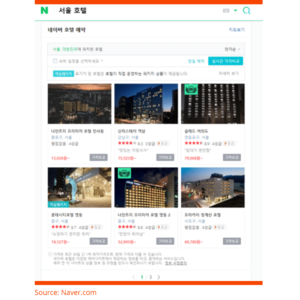
Points to consider: The most important functionalities of Naver – e.g. the search engine, Naver Blog or Naver Café – are not localised into English. The exceptions include webtoons (online comics), an English–Korean dictionary, and the sign-in page. See to it that your localised content is of the highest possible quality; otherwise you might finish the race before you even start it.
Naver is tailored to the behaviours and needs of a very specific consumer, how very different from those attributed to Western customers and visible in their purchase path. This demands a new strategy.
Naver search results: a map of suggested accommodation points

Naver search results: blog content
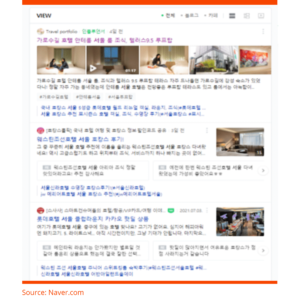
Naver search results: news
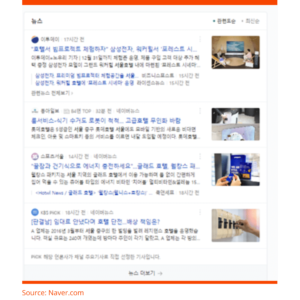
Naver search results - bottom of page: organic search results
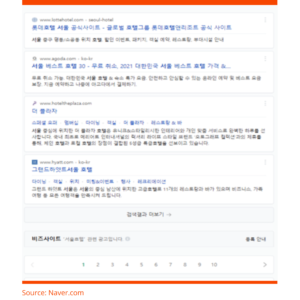
Naver Blog, Naver Café, and Q&A: the power of influencer marketing
Although the influencer marketing strategy works in European markets too, it is a particularly important pillar of e-commerce in Korea. It has a lot to do with the habits of the customers from that area. Koreans pay particular attention to the opinions of other customers and take them into account before they decide whether or not to finalise a transaction. As many as 71% of Korean consumers are more eager to make a purchase if a product has been recommended in social media. According to yet another study, 86% of Korean women look up customer reviews on the internet before making the final decision. This information is especially valuable if your business involves children’s products and services, or if you work in such industries as beauty and fashion.
Naver search results reflect the value of influencer marketing
The design of the search engine reflects the tastes of the South Korean population. Content from blogs, Café or Q&A section is always going to be positioned higher in search results than the website of your company. Therefore, while devising a marketing strategy, you should focus on creating bonds with customers, and consult the Naver keyword planner.
Influencer marketing and South Korean weddings
The influencer marketing in South Korea is really well-developed. Almost every bride can organise a wedding virtually for free. All they need to do – within the frames of a collaboration deal with a company offering wedding packages (e.g. a wedding hall, a photo session, a wedding dress or make-up services) – is to give an account of their preparations. They run a dedicated social media account, share photos in the message board, and give their opinions. For each of those activities one can collect points and exchange them for money or use to pay for some of the services. A youtuber (a girl from Poland) living in South Korea has taken advantage of this opportunity.
For more information about the differences between running a marketing campaign using Google and Naver, go here.
The most popular online orders categories
According to the Statista database, in 2020, the Koreans spent most on food and beverages. Next in the ranking were home electric appliances, as well as electronic and telecommunication equipment. Further down in the ranking, we can find gastronomic services, clothing, household goods, and cosmetics.
The most popular Korean e-commerce platforms
The Koreans usually make their online orders using platforms like:
- Gmarket,
- 11 Street,
- com,
- Coupang (known as “the Korean version of Amazon”).
E-commerce payment systems in Korea
When paying for an online order on a Polish portal, there is little chance of facing an unknown challenge. In most cases, we’ll see the same familiar icons: MasterCard/Visa, PayU, Blik, PayPal, or the (relatively) recently introduced PayPo. If you want to enter the Korean e-commerce market, you have to adjust payment gates to your target group’s preferences.
The top 5 payment methods usually chosen by Koreans are:
- Shinhan Card – 41%
- Kakao Pay Simple Payments – 41%,
- SKT Carrier Billing – 35%
- Naver Pay Simple Payments – 34%
- Kookmin Bank Transfer – 33%
South Koreans’ Payment Methods:

How to communicate with the Korean target group?
Bear in mind that South Korea is a country with strong Confucian traditions. Here, all business relationships and differences in age or social status are reflected in the required vocabulary and proper suffixes (“honorifics”). That is why during the preparation stage – before you embark on a marketing campaign of a product or a service – remember to use the correct style and tone in all communication related to marketing. See both to your content (Koreans pay attention to other product qualities than Europeans) and the form of expression, which might require a bit of polishing or some extra layer of politeness.
Entering the Korean e-commerce market requires detailed arrangements and an entirely new business and communication strategy. Potential hurdles, as well as differences in customer behaviour and habits can come to the surface in various areas.
Additional sources:
Jobst, N., ‘Online shopping transaction value 2020, by category’ (7 Jun. 2021), Statista, https://www.statista.com/statistics/314776/most-popular-social-commerce-product-categories-in-south-korea/.
Stiltner, M., ‘South Korea eCommerce Trends and Merchant’s Guide’ (28 Oct. 2020), Rapyd, https://www.rapyd.net/blog/south-korea-ecommerce-trends-and-merchants-guide/
The Marketing Samurai, ‘Your Guide to Naver’ (19 Nov. 2018), Info Cubic, https://www.infocubic.co.jp/en/blog/south-korea/your-guide-to-naver/
Jobst, N., ‘Online shopping transaction value 2020, by category’ (7 Jun. 2021), Statista, https://www.statista.com/statistics/314776/most-popular-social-commerce-product-categories-in-south-korea/.
Stiltner, M., ‘South Korea eCommerce Trends and Merchant’s Guide’ (28 Oct. 2020), Rapyd, https://www.rapyd.net/blog/south-korea-ecommerce-trends-and-merchants-guide/
The Marketing Samurai, ‘Your Guide to Naver’ (19 Nov. 2018), Info Cubic, https://www.infocubic.co.jp/en/blog/south-korea/your-guide-to-naver/.


![Fashion content marketing [header image] - Loc At Heart Translation Agency](https://locatheart.com/wp-content/uploads/2021/08/Fashion-content-marketing-Loc-At-Heart-Translation-Agency-450x231.png)

![Language quality in e-commerce [featured image] - translation agency LocAtHeart](https://locatheart.com/wp-content/uploads/2021/12/LAH_blog_naglowek_nowy_rozmair-450x231.png)

Leave a Reply